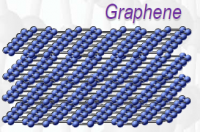Based on new ballistic test results scientists may have discovered graphene as a new material that could be used for bullet proofing purposes. During ballistic tests, tiny silica spheres were shot at the graphene material; researchers found that graphene’s layer just an atom thick is much stronger than steel when impacted by ballistic test shots.
 |
The Building block of graphite
Image credit: Nobelprize.org |
Researchers from the University of Massachusetts in Amherst observed with lasers as microbullets were fired at 10-100 layers of graphene sheets arranged over one another. The observers found that measured energy spheres made on the graphene material before and after the shots dissipated by stretching into a cone shape before cracking. This means only one thing: graphene has the great elasticity of absorbing 8 to 10 times the impact of steel.
“Graphene is a form of carbon. As a material it is completely new – not only the thinnest ever but also the strongest. As a conductor of electricity it performs as well as copper. As a conductor of heat it outperforms all other known materials. It is almost completely transparent, yet so dense that not even helium, the smallest gas atom, can pass through it. Carbon, the basis of all known life on earth, has surprised us once again.”(1)
Geim and Novoselov form the University of Manchester, UK extracted the graphene from a piece of graphite such as the one that is found in ordinary pencils. The two used regular adhesive tape; they managed to obtain a flake of carbon with a thickness of just one atom. It was at a time who many believed it was impossible for such thin crystalline materials to be stable.
“However, with graphene, physicists can now study a new class of two-dimensional materials with unique properties. Graphene makes experiments possible that give new twists to the phenomena in quantum physics. Also a vast variety of practical applications now appear possible including the creation of new materials and the manufacture of innovative electronics. Graphene transistors are predicted to be substantially faster than today’s silicon transistors and result in more efficient computers.
Since it is practically transparent and a good conductor, graphene is suitable for producing transparent touch screens, light panels, and maybe even solar cells.
When mixed into plastics, graphene can turn them into conductors of electricity while making them more heat resistant and mechanically robust. This resilience can be utilised in new super strong materials, which are also thin, elastic and lightweight. In the future, satellites, airplanes, and cars could be manufactured out of the new composite materials.”(1)
The latest discovery just showed that particles of proton could pass through graphene materials and this makes it a good candidate for improving hydrogen fuel cells. It is made essentially of carbon, graphene is an almost transparent sheet with the ability to conduct electricity as well used for anti-ballistic armor technology, and this makes it a highly two-dimensional material that reacts with light and other properties.
1) http://www.nobelprize.org/nobel_prizes/physics/laureates/2010/press.html